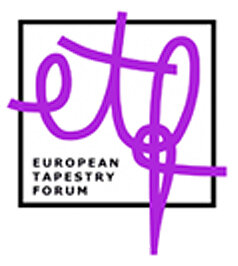ARTAPESTRY7 Exhibition Catalog
TOPICS
By Isa Fleischmann
Director for European Textiles and Clothing
Deutsches Textilmuseum Krefeld
Space and Line
Today, the medium of tapestry allows unusual forms of design and pictorial subject. Spatiality, space and geometrical correlations are be depicted and thematized in different ways. Common to many works of art is the black ground, from which various abstract forms or figurative elements stand out and create a spatial dimension. The line as an essential creative means often takes a dominant position within the pictorial composition.
Photo: Stine Pagter
Gudrun Pater Pillar
Works: E. Kedzia, Nebuleuse II; L. Green, Interdiction; E. Balogh, Resonance; S. Berg, Guilloché IV; G. Pagter, Triptych Pillars.
Dominance of Colour
Colour has always played an important role in the design of pictures. Sometimes works of art form veritable colour studies that cast a spell over the viewer. Tapestry provides various possibilities to set emphasis colour accents through different textile materials and technical features. Above all, abstract or abstracted colour field studies with different textures dominate, while figurative elements are formed as colour surfaces in various spatial representations.
Photo: Birgitta Hallberg
Birgitta Hallberg My family
Works: F. Jakubauskas, Gray spiral; F. Jakubauskas, Three spheres; L. Martin, Untitled; A.-M. Rugescu, Chromatic rhythm; B. Hallberg, My family; M.-T. Brichard, Poles 5; B. Been, Three stockings and a shirts front embroidery; A. Donner, Kirgisian butterfly; P. Horn, Prayer for Christopher Columbus.
Animal Tales – Fauna
The animal in its isolated representation, isolated from man and nature, forms the theme of some of the artworks in the selection for ARTAPESTRY 7. Regardless of how the pictorial design is approached, man’s treatment of the animal and its wildlife living space nourishes thought and encourages us to reflect on our own attitude to the habitat of wild animals. In many parts of Europe, the wolf, elk, lynx and black mourning butterfly are endangered species that require special protection by humans. The intense gaze of the ”lynx”, for example, formulated only in brown-beige, white and black areas, provokes a reaction and reflection.
Photo: Bartosz Zielinski
Alexandra Parol There will be blood
Works: I. Walczak, Triptych Neptis rivularis; T. H. Sørli, Selfexpression; A. Olsson, Lynx 5; M. Hansen, Animal Tale; A. Parol, There will be blood.
Play with Perception
Embers spraying sparks, black-brown surfaces that only hint at trees through their small branches and suddenly reveal a spatial rendition of birch trunks to appear in the eye of the beholder. Or a collection of brushstroke-like spots, dots and lines on a beige background, which only slowly give rise to the image of an olive grove. The possibilities for playing with the viewer’s perception are just as great in tapestry weaving, if not greater, than in painting.
Photo: Charles Cooper
Ann Naustdal Embers
Works: D. Taranek, Imago olivetum; D. Grinbergs, Birches; A. Naustdal, Embers; A. Brusgaard, Petits gubbes d’or de la terre noire.
Elements of Nature
Nature, which surrounds mankind and is particularly threatened in our time, consisting of the plant world with animals and the element of water, which occupies huge areas of the earth, has been a subject worthy of painting since ancient times. Artists from different countries and cultures approach this theme in either poetic or contrasting imagery, whether in the technique of classical or modified tapestry or by means of Jacquard weaving. The methods of representation are different and the degree of abstraction in the picture varies.
Photo: Michael Wolchover
Joan Baxter Still after sunset
Works: I. Prane, In the garden of life; L. Frølund, Trees; H. Spidzane, I will meet you at the river; S. Perret, The Crescuspular Zone; J. Baxter, Still after sunset; A. Kajaniemi, In the depths.
Human Existence
The human being in his vulnerability and mortality, as well as the question of what role faith and religion play today, offer a large field of themes for a pictorial artistic translation into the textile technique of tapestry and jacquard weaving. Colour and surface design form strong carriers of meaning in the mostly figurative works of art, which are used in different ways in pictures. The variety of approaches to this theme and the imaginative modes of design are surprising in the selection for this new ARTAPESTRY exhibition.
Photo: Lazim Dermaku
Irina Kolesnikova The cage
Works: I. Kolesnikova, The Cage; A. Kajaniemi, Depression; M. Piirsalu, With the book; L. Rage, Where does the road lead; R. Rozsivalova, Balance of Eternity; C. Groza, Voyage dans l’inconnu; M. Eicher, Assunta; M. Eicher, Face & Identity.






